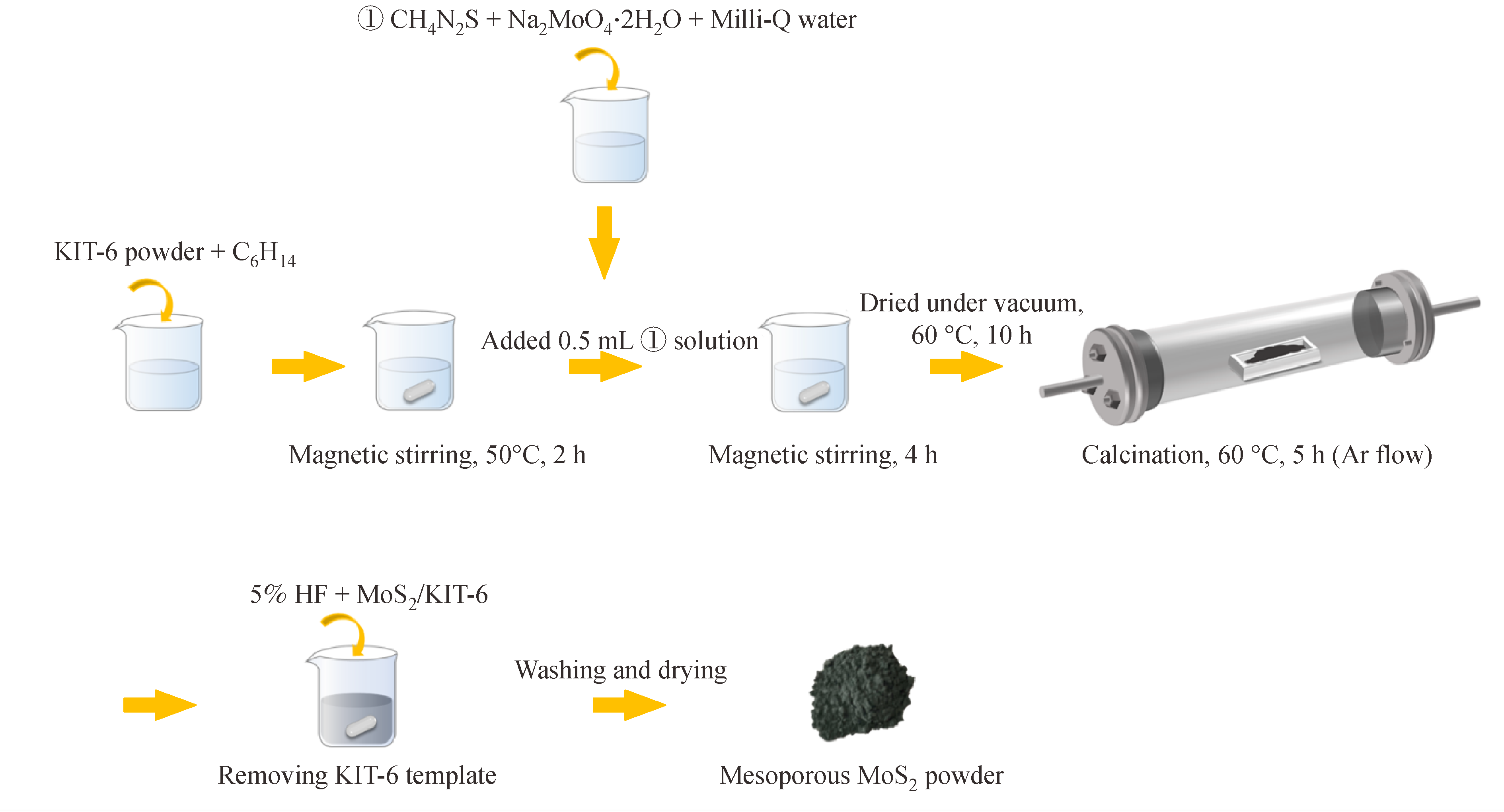

Enhancing the photoelectrochemical performance of p-silicon through TiO2 coating decorated with mesoporous MoS2
Received date: 30 Mar 2021
Accepted date: 30 Jul 2021
Published date: 15 Sep 2021
Copyright
MoS2 is a promising electrocatalyst for hydrogen evolution reaction and a good candidate for cocatalyst to enhance the photoelectrochemical (PEC) performance of Si-based photoelectrode in aqueous electrolytes. The main challenge lies in the optimization of the microstructure of MoS2, to improve its catalytic activity and to construct a mechanically and chemically stable cocatalyst/Si photocathode. In this paper, a highly-ordered mesoporous MoS2 was synthesized and decorated onto a TiO2 protected p-silicon substrate. An additional TiO2 necking was introduced to strengthen the bonding between the MoS2 particles and the TiO2 layer. This meso-MoS2/TiO2/p-Si hybrid photocathode exhibited significantly enhanced PEC performance, where an onset potential of +0.06 V (versus RHE) and a current density of −1.8 mA/cm2 at 0 V (versus RHE) with a Faradaic efficiency close to 100% was achieved in 0.5 mol/L H2SO4. Additionally, this meso-MoS2/TiO2/p-Si photocathode showed an excellent PEC ability and durability in alkaline media. This paper provides a promising strategy to enhance and protect the photocathode through high-performance surface cocatalysts.

Hongmei WU , Feng LI , Yanqi YUAN , Jing LIU , Liping ZHAO , Peng ZHANG , Lian GAO . Enhancing the photoelectrochemical performance of p-silicon through TiO2 coating decorated with mesoporous MoS2[J]. Frontiers in Energy, 2021 , 15(3) : 772 -780 . DOI: 10.1007/s11708-021-0783-7
| 1 |
Strandwitz N C, Turner-Evans D B, Tamboli A C,
|
| 2 |
Yue P, She H, Zhang L,
|
| 3 |
Li Y, Yang Y, Huang J,
|
| 4 |
Sun K, Shen S, Liang Y,
|
| 5 |
Liu D, Ma J, Long R,
|
| 6 |
Fan R, Zhou J, Xun W,
|
| 7 |
Li H, Wang T, Liu S,
|
| 8 |
Zheng J, Lyu Y, Wang R,
|
| 9 |
Zhou X, Liu R, Sun K,
|
| 10 |
Fu Q, Wang W, Yang L,
|
| 11 |
Xun W, Wang Y, Fan R,
|
| 12 |
Fan R, Dong W, Fang L,
|
| 13 |
Li F, Yuan Y, Feng X,
|
| 14 |
Lin H, Li S, Yang G,
|
| 15 |
Seger B, Pedersen T, Laursen A B,
|
| 16 |
Chen C J, Veeramani V, Wu Y H,
|
| 17 |
Wang H, Zhang L, Chen Z,
|
| 18 |
Li S, Zhang P, Song X,
|
| 19 |
Fu H, Varadhan P, Tsai M L,
|
| 20 |
Zhu L, Lin H, Li Y,
|
| 21 |
Liu J, Wu H, Li F,
|
| 22 |
Hu C, Zhang L, Gong J. Recent progress made in the mechanism comprehension and design of electrocatalysts for alkaline water splitting. Energy & Environmental Science, 2019, 12(9): 2620–2645
|
| 23 |
Ding Q, Meng F, English C R,
|
| 24 |
Kwon K C, Choi S, Lee J,
|
| 25 |
Wang H, Xiao X, Liu S,
|
| 26 |
Kiriya D, Lobaccaro P, Nyein H Y Y,
|
| 27 |
Karunadasa H I, Montalvo E, Sun Y,
|
| 28 |
Wang W, Zhu S, Cao Y,
|
| 29 |
Kibsgaard J, Chen Z, Reinecke B N,
|
| 30 |
Li X, Li Y, Wang H,
|
| 31 |
Li F, Wang C, Han X,
|
| 32 |
Rasamani K D, Alimohammadi F, Sun Y. Interlayer-expanded MoS2. Materials Today, 2017, 20(2): 83–91
|
| 33 |
Tsai C, Abild-Pedersen F, Nørskov J K. Tuning the MoS2 edge-site activity for hydrogen evolution via support interactions. Nano Letters, 2014, 14(3): 1381–1387
|
| 34 |
Fan R, Mao J, Yin Z,
|
/
| 〈 |
|
〉 |